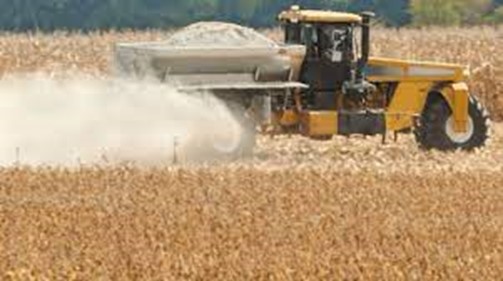 Image 1. Lime spreader applying lime.
Image 1. Lime spreader applying lime.
- Grid soil sampling and yield maps are the best tools to establish fertilizer recommendations.
- Lime applications to correct soil pH are critical to maximize nutrient availability.
- Maintenance applications of P & K replace the nutrients taken off by the previous crop.
- Build-up applications increase the levels of P & K to critical test levels which maximizes yield
The fall season is the first opportunity to establish yield potential for the crop that will be planted the following spring. Grid sampling is a tool to establish baseline fertility values for lime, phosphorous (P) and potassium (K), and is the best way to ensure we find the true variability in a field. Basing application of lime and fertilizer on grid sampling is the most accurate way to ensure that there is enough fertilizer available to support crop growth and limit unnecessary over-application of lime and fertilizer.
Lime applications to correct soil pH is a critical step in the Fall Fertility To-do list. Soil pH needs to be between 6.0-7.0 to prevent nutrient tie-up and ensure that fertilizer applications can be used for crop growth (figure 1). Grid sampling is the best way to ensure we are only applying lime where needed. If we apply lime, and increase our soil pH, where it is not necessary, we can tie up nutrients and make them unavailable to our crop (Figure 1).

Figure 1. Soil pH and nutrient availability
Applications of P & K are based on both, “build-up” and “maintenance” levels. Maintenance applications are based on the previous crops yield and replace the amount of P & K that the previous crop removed. Maintenance applications of P and K fertilizer do not increase yield potential – they are replacing what has been taken off during harvest.
Build-up applications of fertilizer are used to increase the levels of P & K to critical soil test levels. Building P & K to critical soil levels ensures that there is enough fertility in the soil to maximize yield. By building to critical levels, we make sure soil fertility will not be a yield limiting factor for the year. If P & K are below the critical test levels, fertility could be a yield limiting factor.
To raise the soil test level of P & K by 1 lb/A, it takes 9 lbs/A of P2O5 and 4.5 lbs./A K2O, respectively. If you need to raise it by 1 ppm then you will need 18 lbs/A of P2O5 and 9 lbs/A of K2O.
For more information on fall fertilizer strategies or how to maximize your yield potential while staying on budget contact your FS Crop Specialist.